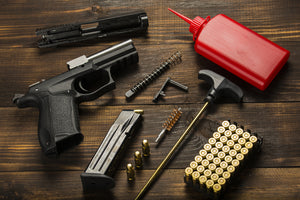Respecting the Responsibility
Thanks to the advent of comic book movies into the mainstream, there’s likely not a soul in the Western world who can’t recite the mantra of Spider-man’s Uncle Ben from heart: “with great power comes great responsibility.” Never is this more true than with owning a gun. Not only must that owner be aware of their surroundings when handling a gun, but they must also be fully aware of the mechanical condition of their firearm as well.
It is standard operating procedure for those who wish to get a gun permit to have to take a safety course. Here is where the instructor will teach everyone about proper handling techniques and how to care for their firearm, while also making them aware of the state and federal expectations that are in force for gun owners.
At 45 Blast, guns aren’t simply our profession, they’re our passion and our hobby; everything of importance in our lives requires a certain amount of looking after to make sure they’re okay. Let’s take a moment to refresh ourselves on the best practices of gun maintenance so that their performance never falters.
The Three Pillars of Proper Maintenance
The business of 45 Blast is mainly the business of gun accessories. Securing attachments to our firearms to make them easier to fire and to carry — like our famous Canik compensator or our forthcoming holster — is important to us, which means we have a healthy respect for the components of a gun.
Proper gun care has much to do with taking care of those components. In fact, there are three categories of acceptable maintenance by which every owner should abide. They are:
- Cleaning
- Lubrication
- Safety
While we treat these as separate steps of the process, a wise gun owner understands how each affects the other. Cleaning the gun, for instance, is not a time to treat safety as an afterthought.
Cleaning
Though there are many differing views on how best to clean your gun (most of which have to do with the different model, its age, and the wear on the firearm), it is more or less widely acknowledged that your gun should be cleaned at least once a week.
Again, in terms of how the cleaning is to be done, the field guide for your firearm (as well as myriad voices on the internet) will be happy to instruct you on the step-by-step process of disassembling and cleaning your gun. For our purposes, we simply want to remind you of the most important guidelines:
- Insuring the gun is unloaded: You will want to remove the magazine and any round that is in the chamber. The magazine should be empty as well and live ammunition should not be kept in another room altogether.
- Be able to identify every part of the gun: There are lots of components to a firearm — far more than even the most advanced gun accessories. Can you identify the frame, slide, barrel, recoil spring, and magazine?
- Have all your tools in proper order and ready to go: There are no half measures when it comes to cleaning your gun. Review that you have everything you need and make sure that it’s ready to do a good job.
Remember that your gun’s user manual will be your best friend in all of this. Each gun has its own personality, its own quirks; one of 45 Blast’s guns like the Canik will feel different from a Smith & Wesson. Cleaning your gun is a great way to get more familiar with it.
Lubrication
The same is true for lubricating gun parts as it is for lubricating car parts: the mechanism’s moving parts need as little friction as possible to increase their longevity. Your gun’s manufacturer may require you to use one type of lubricant over another. These typically fall into two categories:
- Oil
- Grease
The main difference between the two types of lubrication is the viscosity; oil has a lower viscosity than grease and is, therefore, better suited for the finer parts of the gun that operate closely together, like trigger mechanisms and firing pins. Grease, on the other hand, is a thicker substance and is best for those parts of the gun that don’t carry the stress of fine-tuned movement, like bolt carriers.
Safety
You might be wondering how and why “safety” is considered a category of maintenance. As a general rule, safety should be the first priority when servicing any part of the firearm, either during the cleaning or lubrication stage. But this category also covers the maintenance of the gun owner’s memory.
The person who owns and operates the firearm needs maintenance just as much as the tool itself. That’s why it is important to remind yourself of the golden rules of gun safety and to go over the proper protocols on a semi-regular basis.
A+ Shooting
Once the gun is fully cleaned and lubricated and you have sufficiently reviewed the proper etiquette of owning and operating the gun, then your gun is ready to reach new levels of accuracy and performance. The purchase of the right gun accessory, like our own Canik compensator, will give you an edge in every situation you find yourself in, whether it’s out on the firing range or in a dangerous situation.
Visit 45 Blast’s website often to keep up to date on the latest in stylish and helpful gun attachments.


